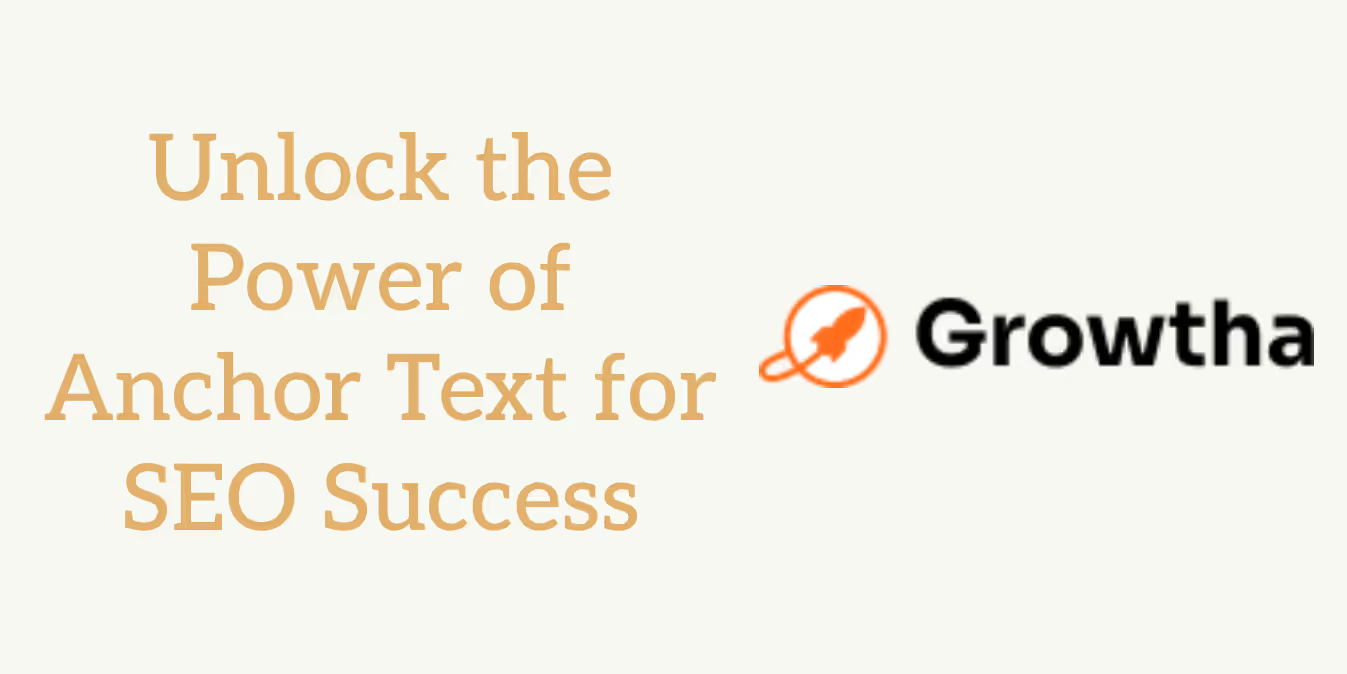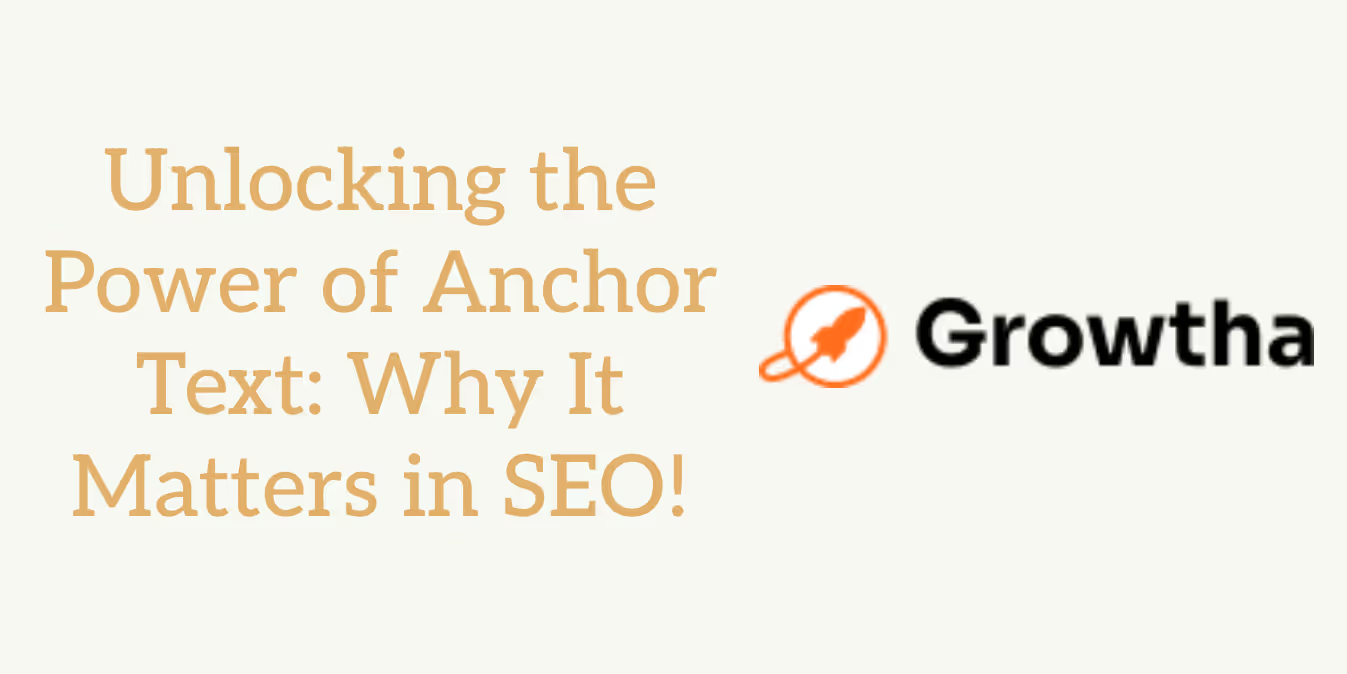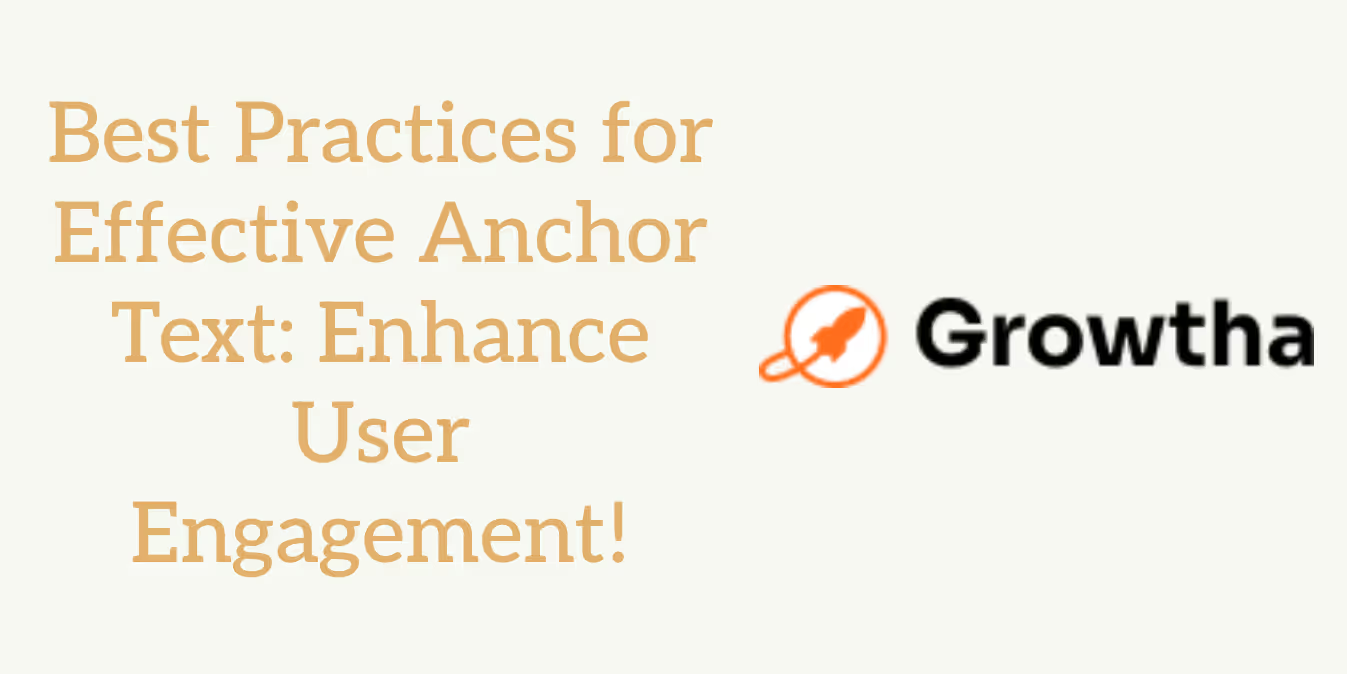9 Best Anchor Text Practices
Anchor text is a fundamental yet often overlooked component in the world of web navigation and search engine optimization (SEO).


9 Best Anchor Text Practices
9 Best Anchor Text Practices You Need to Know

Introduction to Anchor Text
Anchor text is a fundamental yet often overlooked component in the world of web navigation and search engine optimization (SEO). It is the clickable text within a hyperlink that directs users to their destination. By succinctly summarizing what users can expect from the linked content, anchor text enhances user experience and assists in guiding search engines regarding the relevance of that content. Imagine wanting to buy a pair of red running shoes and spotting an anchor text that reads "Shop Red Running Shoes Here"—not only is it informative, but it serves as a persuasive invitation to click. The importance of anchor text cannot be overstated; proficient use can significantly influence how search engines rank your pages, thereby improving your site's visibility. Moreover, strategic anchor text contributes to higher user engagement, as clear and descriptive links encourage users to learn more. But it's not just about using any keywords or phrases; the way anchor text is crafted can either make or break your SEO strategy.
What is an example of an anchor text?
Understanding Anchor Text
Anchor text is the clickable text that forms part of a hyperlink, guiding users through the vast landscape of the internet. It serves as a navigation aid, succinctly summing up what to expect upon clicking the link. For example, a phrase like "buy blue sneakers online" isn't just a random collection of words; it explicitly indicates that the linked page will provide options for purchasing blue sneakers online. This clarity is what makes anchor text an essential element in web design and search engine optimization (SEO).
The Role of Anchor Text in SEO
Proper usage of anchor text plays a vital role in improving a website's SEO. It contributes to better user experience and helps search engines identify the relevance of the linked content. Here are some reasons why effective anchor text usage is crucial:
Benefits of Using Anchor Text Effectively
- Enhances user understanding of the linked content
- Boosts search engine rankings when used strategically
- Encourages click-through rates by clearly conveying the link's value
- Promotes a natural flow of content, making it easier for users to navigate
Balancing Anchor Text for Optimal Impact
While anchor text can significantly boost your SEO efforts, it is crucial to approach it with balance and diversity. Overusing exact keyword matches can be detrimental, potentially signaling to search engines that you're engaging in manipulative SEO practices. To maintain a healthy link profile, consider adhering to the following guidelines:
Guidelines for Effective Anchor Text
- Limit exact match anchor texts to 10% or less of your total anchor text
- Diversify your anchor texts by using variations of your keywords
- Incorporate branded or generic terms where appropriate
- Focus on natural language that enhances user experience
Conclusion
Anchor text is more than just a tool for navigation; it’s a critical component of effective online content strategy. By understanding its importance and mastering its use, you can enhance both your users' experience and your website's visibility.
Types of Anchor Text
Type Description Example Exact Match Contains the exact keyword of the destination page. "best digital cameras" Partial Match A variation that is relevant to the destination page. "effective SEO strategies" Branded Includes the brand name for recognition. "Nike" Generic Common phrases with minimal context. "click here" Naked URL The full URL as the anchor text. "www.example.com" LSI Related keywords that enhance context. "digital advertising" Image Anchor Text Uses the alt text of an image for links. (image of "blue sneakers")

What is anchor text and why is it important in SEO?
Anchor text refers to the clickable text in a hyperlink, serving as a signpost for both users and search engines. This seemingly inconspicuous element plays a crucial role in online navigation, as it provides essential context about the linked content. When a user hovers over or clicks on an anchor text, they receive an indication of what to expect from the destination page. This clarity not only enhances user experience but also aids in the overall functionality of the web.
From an SEO perspective, anchor text is vital. It informs search engines regarding the relevance and subject matter of the linked page. By analyzing this text, search engines can index and rank pages more effectively. Poorly chosen anchor text could lead to a misunderstanding of page content, ultimately affecting visibility in search results.
Types of Anchor Text
There are several types of anchor text, each with its specific role in linking strategies. These include:
1. Exact Match Anchor Text
This consists of the target keyword or phrase from the destination page. For example, if the page you're linking to is about digital marketing strategies, using that exact phrase as anchor text is considered an exact match.
2. Partial Match Anchor Text
This involves using keywords or phrases that are relevant to the destination page but not perfectly aligned with it. For instance, you might use marketing strategies when linking, which is related but not identical.
3. Branded Anchor Text
This type includes the name of the brand, such as Nike or Apple, linking to their respective web pages. It helps in building brand recognition.
4. Generic Anchor Text
These are non-descriptive phrases like click here or read more. While they’re commonly used, they provide minimal context to users and search engines.
Best Practices for Optimizing Anchor Text
To make the most of anchor text, adhere to the following best practices:
- Use Descriptive Text: Ensure the anchor text gives a clear idea of what the link is about.
- Be Concise: Keep it brief yet informative to capture user interest without overwhelming them.
- Avoid Over-Optimization: Repeating keywords excessively can lead to penalties from search engines.
- Maintain Relevance: Always link to content that closely aligns with the anchor text for improved ranking.
When implemented properly, optimized anchor text can significantly elevate both user experience and a website's SEO performance.
What are the different types of anchor text used in link building?
In the complex world of search engine optimization (SEO), understanding the various types of anchor text utilized in link building is crucial. Not only does it enhance the potential of your site's ranking, but it also influences how search engines evaluate the relevance of your links.
Types of Anchor Text
Below are the primary categories of anchor text that SEO professionals and marketers should consider when developing their link strategies:
- Exact Match: This type contains the exact keyword corresponding to the linked page. For instance, using 'best digital cameras' connects directly to a page with that exact term.
- Partial Match: A variation of the exact keyword, such as 'effective SEO strategies', this approach helps diversify your anchor text.
- Branded: Utilizing the brand name in anchor text, like 'Nike', reinforces brand recognition and trust.
- Generic: These are non-descriptive phrases such as 'click here' that offer less context but can still be effective in certain scenarios.
- Naked URL: Employing the actual URL itself, as in 'www.example.com', often aids in link building by simply pointing directly to the source.
- LSI (Latent Semantic Indexing): Incorporates related keywords, enhancing context; for example, 'digital advertising' connects well with search intent.
- Image Anchor Text: This leverages the alt text of an image to provide an additional layer of context for both users and search engines.
The strategic use of these diverse anchor text types can vastly improve link-building outcomes, enabling websites to climb the search engine rankings with a well-rounded approach.
How do different types of anchor text impact SEO?
Understanding Anchor Text Types
Anchor text, the clickable text in a hyperlink, plays a crucial role in search engine optimization (SEO). The way it is crafted can dramatically influence how search engines perceive and rank a website. Diving into the different types of anchor text allows webmasters and SEO professionals to implement strategies that not only enhance visibility but also position their sites positively in the eyes of search engine algorithms.
1. Exact Match Anchor Text
This type of anchor text matches the exact keyword you want to rank for. If used judiciously, exact match anchor text can significantly boost your SEO rankings. However, overuse can trigger spam filters, so a balanced approach is advisable.
2. Branded Anchor Text
Utilizing your brand name in hyperlinks as branded anchor text serves a dual purpose. It builds brand recognition while enhancing authority and trustworthiness. This type affirms to search engines that users are seeking out your brand specifically.
3. Partial Match and Related Anchor Text
These anchors contain variations of your target keywords or synonymous phrases. Partial match and related anchor texts diversify backlinks, reducing the risk of being flagged as spam. They contribute to a more natural linking profile, which search engines favor.
4. Generic Anchor Text
While they might seem harmless, generic anchor texts such as 'click here' or 'read more' carry minimal relevance and should generally be avoided. They do little to strengthen your SEO strategy, offering no context or keyword association.
Conclusion
In summary, a natural distribution of different anchor text types signals to Google that you are employing a genuine linking strategy. Crafting a well-rounded anchor text profile can enhance your website's search engine authority, ultimately leading to better rankings.
Impact of Anchor Text Types on SEO
Anchor Text Type Benefits Potential Risks Best Usage Practice Exact Match Can significantly boost rankings for target keywords. Overuse can trigger spam filters. Use sparingly and in context. Branded Builds brand recognition and trust. Can appear too promotional if overused. Use when referring to your brand. Partial Match Diversifies backlinks, reducing spam risk. Might dilute keyword targeting. Use variations relevant to linked content. Generic Useful for non-informative links. Offers minimal context to users and search engines. Avoid; opt for descriptive phrases.

What are best practices for using anchor text in web content?
Understanding Anchor Text
In the realm of web content, anchor text plays a pivotal role in guiding users and search engines. This clickable text should not only attract attention but also provide a meaningful context regarding the linked material. Harnessing the power of effective anchor text can significantly enhance user experience and SEO performance.
Essential Best Practices
To maximize the impact of anchor text, consider the following best practices:
Key Best Practices for Anchor Text
- Keep it Natural: Ensure that links fit seamlessly within the surrounding content, maintaining the flow of information. Avoid forced or awkward insertions.
- Be Succinct: Aim for concise phrases; ideally, your anchor text should be no longer than five words. This brevity aids clarity.
- Use Descriptive Text: Craft anchor text that accurately describes the linked content, allowing users and search engines to understand what to expect.
- Ensure Visual Identifiability: Make sure that links stand out — use color, underlining, or bold text to differentiate them from regular text.
- Vary Your Anchor Text: Diversify the types of anchor text used throughout your site to evade penalties from search engines for over-optimization.
Avoiding Common Pitfalls
Certain phrases should be avoided to maintain the integrity of your anchor text. Generic options like 'click here' offer little context and fail to enrich the user's understanding of your content. Instead, strive for specificity to enhance both user engagement and search engine optimization.
What should be avoided when creating anchor text?
Creating effective anchor text is crucial for enhancing user experience and optimizing search engine visibility. However, certain practices should be avoided to ensure that the links serve their intended purpose without detracting from the quality of the content.
1. Avoid Generic Phrases
Using phrases like ‘click here’ or ‘read more’ fails to provide context about the linked content. These generic expressions do not inform users about what they will find if they follow the link, reducing their click-through incentive. Instead, aim for descriptive phrases that give a clear indication of the content's focus.
2. Steer Clear of Keyword Stuffing
Excessive use of keywords in anchor text, particularly those designed for exact match optimization, can lead to over-optimization. This approach not only makes the text sound unnatural but also raises red flags for search engines, potentially labeling the content as spammy.
3. Diversify Your Anchor Text
Consistently using the same anchor text across multiple links can harm your website's SEO health. Diversifying anchor text helps maintain a natural link profile. By varying the language and structure of your links, you mitigate the risk of search engine penalties and create a more engaging experience for users.
In summary, when crafting anchor text, focus on clarity, avoid over-stuffing with keywords, and embrace diversity in phrasing to enhance both user engagement and search engine optimization.
Why is anchor text considered a ranking factor for search engines?
In the intricate dance between search engines and websites, anchor text emerges as a pivotal player in determining the relevance and authority of content. It serves not merely as a clickable phrase but as a powerful signal to search algorithms regarding the nature of the linked page. When a hyperlink includes descriptive anchor text, it essentially provides a preview of what one can expect upon clicking, enhancing both the user experience and contextual clarity.
Search algorithms employ anchor text for several critical purposes, including how they index linked content. This indexing influences search rankings, ultimately determining where a page may appear in search results. It acts as a guide that helps the algorithms discern whether the linked website is relevant to a user's search query.
Key Factors of Anchor Text's Influence on SEO
Several factors highlight why anchor text plays such an essential role in search engine optimization (SEO):
Factors
- Descriptive Nature: Anchor text that accurately describes the linked content helps search engines gauge relevance more effectively.
- Keyword Relevance: Including keywords that reflect the content of the linked page can enhance search rankings.
- User Engagement: Descriptive anchor text tends to improve click-through rates, signaling quality to search engines.
- Contextual Clarity: Anchor text provides context not only to users but also to search engines, reinforcing the thematic relationship between the linking and linked pages.
Ultimately, recognizing the importance of anchor text in linking strategies allows webmasters to optimize their sites more effectively. By carefully crafting anchor text, website owners can significantly influence their search visibility and engagement, paving the way for a better overall performance in search engine results.
What are the general recommendations for creating effective anchor text?
The Foundation of Effective Anchor Text
Creating effective anchor text begins with a strong understanding of its role in web navigation and SEO. Anchor text, the clickable text in a hyperlink, should not be an afterthought but an intentional choice that guides users and search engines alike. When executed properly, effective anchor text enhances user experience while also bolstering search engine optimization efforts.
Characteristics of Strong Anchor Text
To ensure your anchor text serves its purpose well, adhere to the following guidelines:
- Descriptive: The anchor text should clearly indicate what the linked content is about. This helps the user anticipate what they will find upon clicking.
- Concise: Aim for brevity, making sure your anchor text is informative but not overly wordy. The ideal length typically ranges from 2 to 5 words.
- Relevance: The anchor text must be pertinent to both the current page and the linked page. The more relevant it is, the better it will serve both users and search engine algorithms.
Technical Elements to Consider
The technical aspects of anchor text are equally crucial. Using the proper HTML <a> elements with a valid href attribute is non-negotiable, as this format is essential for Google to effectively crawl and index your links. Without this, your links may not be noticed, diluting their potential impact.
Navigating Internal and External Links
In addition to using effective anchor text, it's important to implement both internal and external linking strategies:
- Internal Links: Each essential page should have at least one inbound link from another page on your site. This not only enhances navigation for users but also helps Google discover and rank your content.
- External Links: When citing credible sources, external links can bolster your content's trustworthiness and provide context, further enriching the user experience.
Maintaining a Logical URL Structure
Finally, ensure that your website has a logical URL structure and aligns with Google’s crawling and indexing guidelines. A well-structured site allows for better discoverability and improves the chances of your content being ranked highly in search results.
Recommendations for Effective Anchor Text
Recommendation Description Impact Example Descriptive Clearly indicate linked content. Enhances user experience and relevance. "buy blue sneakers online" Concise Keep anchor text brief (2-5 words). Improves readability and engagement. "best digital cameras" Relevant Relate to both pages involved. Boosts SEO authority. "SEO strategies 2023" Technical Accuracy Ensure correct HTML format for links. Essential for indexing by Google. Correct use of <a href="url">anchor text</a>.
Summary
Conclusion
In conclusion, mastering the art of anchor text is paramount to not only enhancing user experience but also amplifying your website's SEO performance. By implementing the best practices outlined in this article, such as utilizing various types of anchor text and maintaining clarity and relevance, webmasters can construct links that benefit both users and search engines. Avoiding common pitfalls like keyword stuffing and generic phrases ensures a more authentic and effective linking strategy. Ultimately, when anchor text is used wisely, it acts as a powerful tool that signals to search engines the relevance and authority of your content. This, in turn, can lead to improved rankings, increased traffic, and a better overall experience for your audience, which is the ultimate goal of any effective SEO strategy.
References
- What Is Anchor Text? An Overview + Best Practices - Semrush
- SEO Link Best Practices for Google | Documentation
- Anchor Text - Moz
- Anchor Text: What Is It & How To Optimize It? - Search Engine Journal
- Best Practices for Anchor Text Optimization - Neil Patel
- Anchor Text in SEO: Link Building Anchor Text Best Practices - SEO.co
- What is Anchor Text? (Do's and Don'ts to Optimize Link Text)
- Anchor Text for Beginners: How to Optimize It for SEO (2023)
- Anchor Text Optimization - The Ultimate SEO Guide for 2024







